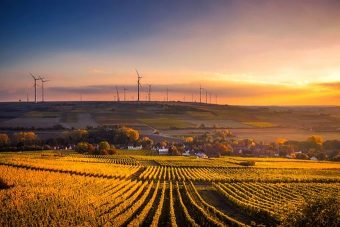
Climate change is affecting wind energy’s potential to provide power, diminishing a renewable energy source that scientists and policymakers are counting on to replace fossil fuels, according to two scientific studies.
The world is turning more and more to renewable sources of energy — wind, solar power, and in some cases energy from flowing water — to fight climate change. But what if climate change itself alters the distribution of wind, or sunlight falling on the Earth’s surface, or river flows, and so changes or even shrinks the potential of these energy sources?
The studies suggest that, at least for wind energy, that is not only happening — at least in some key locations — but that it could grow worse.
“Renewables, including wind, are an important part of many nations’ and even states’ overall strategies for reducing greenhouse emissions,” said Kristopher Karnauskas, a researcher at the University of Colorado, and first author of one of the studies. “So it’s important that we fully understand how the potential efficacy of that mitigation strategy may be changing concurrently with the problem itself. We can’t assume that the baseline wind energy resource is a constant.”
Why would wind energy potential change because of climate change? At the most fundamental level, winds are driven by the unequal distribution of the sun’s energy across the surface of the Earth, which in turn creates regions of different atmospheric pressure. Wind then flows from regions of high pressure to regions of low pressure. Those installing wind turbines try to place them in spots where that flow tends to be particularly strong.
But climate change is also distributing energy unevenly across the planet. In particular, land surfaces are warming up more rapidly than are ocean surfaces, even as the Arctic is warming up much more rapidly than the northern hemisphere’s middle latitudes.
It’s not surprising that the distribution of winds around the Earth would change under global warming. Indeed, in the Southern Hemisphere, some researchers believe that changing winds are responsible for the growing melting of Antarctic glaciers, as they are driving warmer, deeper waters closer to the icy continent.
So how could changing wind patterns affect the deployment and effectiveness of wind energy?
The first of the two studies, recently published in Nature Scientific Reports, gives a first glimpse at an answer. It finds that the nation that has installed more wind energy than any other on Earth — China — is actually seeing a lowering of wind energy potential across vast regions, especially inner Mongolia and Gansu, two of the largest installation areas.
“To my great surprise instead of finding a random signal, we found that it was actually declining,” said Michael McElroy, a Harvard Earth sciences professor who is one of the authors of the study. He conducted the research with Peter Sherman, the first author, and Xinyu Chen of Harvard.
The researchers found, based on a large database of meteorological records, that there already has been a wind energy decline in key regions of China from 1979 through 2015. And they found that this had happened in concert with an overall warming trend, although natural climate fluctuations also played a role.
The change occurred, McElroy said, because the Asian continent has been warming up faster than the Pacific Ocean offshore.
Source: sentinelsource.com



